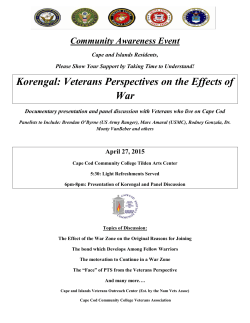
sugar industry wastewater treatment using
Jr. of Industrial Pollution Control 25 (2) (2009) pp 109-112 © Enviromedia Printed in India. All rights reserved SUGAR INDUSTRY WASTEWATER TREATMENT USING ADSORPTION M. SUNITHA, MOHD. ABDUR RAFEEQ Govt. Boys College, Quilla Road, Nizamabad, India Key words : Adsorption, Optical density, Equilibrium. ABSTRACT Sugar Industry Wastewater has high degree of pollution parameters. Some Sugar Industries have Wastewater treatment plants. But the effectiveness of treatment is not considerable. Adsorption in the primary stage of treatment has been proved to be useful in lowering pH, COD, BOD can be found using various models available in literature and the models are modified or wastewaters of Sugar Industry. INTRODUCTION Sugar Industry is one of the major industries which has been included in the polluting industries list by the world bank. Different pollution monitoring agencies like State and National Pollution Control Boards have made compulsory for each industry to set up waste water treatment plants. Most of the waste treatment plants have primary stage by addition of acid/ alkali for neutralization is causing side effects of increasing the amount of total dissolved and suspended solids. This effect hinders the effectiveness of subsequent treatment in lowering of COD,BOD, TDS, TSS amounts of oil and grease. Poisonous pesticides and Organic substances difficult to degrade can also be easily removed by adsorption. Different adsorbent like activated charcoal, Bentonite, Lignite, Mgo and fly ash can be used for adsorption of Sugar Industry wastewater. Use of the above adsorbents helps in 80% removal of TDS, TSS and oil and grease, and in lowering of COD, BOD colour and smell. The present study which is a part of the studies undertaken to study the impacts of Sugar factory effluents, aims at suggesting a new cost effective and reliable method of waste water treatment of Sugar Industry. It involves adsorption in the primary stage followed by pH adjustment and Physcio chemical and biological treatments. Waste water Any inexpensive adsorbent like Bentonite Liginite or Mgo can be used Experimental Procedure Wastewater samples from various selected sample Sugar industries were collected from the process plant streams before they get mixed with the other streams. Often they were highly concentrated. The samples were analysed for pH, COD, BOD, TDS, TSS and colour. About 500 mL. Of the sample was taken in a cylindrical flask, 2.5 gm. Of activated charcoal was added into the flask and magnetic stirrer was Address for correspondence - M. Sunitha D/o M. Bhumaiah, H.No. 4-1-497, SKNR X Roads, Post - Shakarnagar, Dist. Nizamabad - 503 180, E-mail : saisunitha02@yahoo.com 110 SUNITHA AND RAFEEQ started. 5-10ml. Of the sample was drawn in every 15 minute duration from this mass, filtered on a filter paper and PH, COD, BOD colour was anlysed. At the end of 2 hour stirring was stopped and the experiment was terminated. The experiment was repeated with similar amounts of Bentometer and Lignite. Similar equation can be derived for B.O.D. also. The values obtained are comparable with experimental values. RESULTS AND DISCUSSION B.O.D., COD and colour reduction The reduction of BOD and COD was estimated using the standard methods of estimation and applying various models available in Literature for different adsorbents the values are plotted. The efficiency of each adsorbent is also analysed. Graphs CONCLUSION Considering the reduction of COD, BOD colour and four smell obtained for different adsorbents their cost effectiveness and the subsequent use, Lignite, Bentonites can be best applied for treatment of Sugar Industry Waste water. As adsorption is also increasing the efficiency of subsequent stages of Physico – Chemical and biological treatments. This study will be helpful for the sugar industries in cooperative and public sectors and also for small scale Khandsaris. It will certainly help in resolving waste water pollution economically to a large extent. Abbrevations Activated charcoal is found to be more effective. But it is 10 times more expensive than lignites and Bentonite. Bentonite and Lignits are cheaper adsorbents and can be effectively used for the waste water treatment of Sugar Industry. The spent adsorbent can be easily and gainfully disposed along with coal and wood in the boilers to increase the calfornic values as the gained adsorbed substances convert to carbondioxide and water. COD, BOD Equilibrium Prediction The COD and BOD value at different intervals can be predicted using the following models available in Literature. Weber and Mori Equation Ci – C/Ci = mlt 0.5 + C1 Lagergran Equation Log C- C eq = m2t +c2 Rathi Purnik Equation Log C1 – c/t = mt+c (1) (2) (3) B.O.D. C.O.D. C C1 C2 C Ci C eq m,m1,m2 = Biological Oxygen demand = Chemical oxygen demand = Constants = COD at time t = COD initial = COD equilibrium = Time REFERENCES Salto Toshihide and Hagiwara Kazuyoshi, 1985. Research survey on adsorbents in waste water treatment in waste water treatment. Osaka Kogyo Gijutsu Shikensho Kiho. 36 (4) : 237- 245. Wober, W.J. (Jr) and Smith, 1986. Activated carbon adsorption. Stud Envir SC. 29 : 455 - 492. Derika Engineering,1984. COD removal by adsorption. Jpn Koka’s Tokkgo kho. JD. 59 12792. Meghea Aurelia, Dragoniu Mihaela, 1989. Removal of organic impurities from saline waste water by adsorption Rev. Chimyo. 40 (5) : 441. Industrial Water Pollution Control by W-Wesly 1989. Rathi, A.K.A. and Puanik, S.A. 1999. Treatment of waste water pollutants. Am Dyestruff Rep. 88 (7) : 42-50.
© Copyright 2025

















